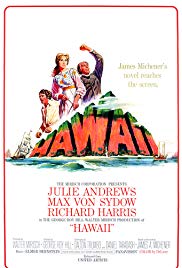HAWAII
SUBJECTS — U.S/1812 – 1860 & Hawaii; Religions/Christianity;
SOCIAL-EMOTIONAL LEARNING — None.
MORAL-ETHICAL EMPHASIS — Respect; Caring.
AGE: 12+; No MPAA Rating;
Drama; 1966; 188 minutes; Color/B & W. Available from Amazon.com.
There is NO AI content on this website. All content on TeachWithMovies.org has been written by human beings.

SUBJECTS — U.S/1812 – 1860 & Hawaii; Religions/Christianity;
SOCIAL-EMOTIONAL LEARNING — None.
MORAL-ETHICAL EMPHASIS — Respect; Caring.
AGE: 12+; No MPAA Rating;
Drama; 1966; 188 minutes; Color/B & W. Available from Amazon.com.
TWM offers the following worksheets to keep students’ minds on the movie and direct them to the lessons that can be learned from the film.
Film Study Worksheet for a Work of Historical Fiction and
Worksheet for Cinematic and Theatrical Elements and Their Effects.
Teachers can modify the movie worksheets to fit the needs of each class. See also TWM’s Historical Fiction in Film Cross-Curricular Homework Project.
This film is a fictional account of the first efforts by missionaries to convert Hawaiians to Christianity. It covers the period from 1820 to about 1840 and is based on the novel by James Michener.
Selected Awards:
1967 Golden Globe Awards: Best Supporting Actress (Lagarde), Best Original Score; 1966 Academy Award Nominations: Best Supporting Actress (Lagarde), Best Color Cinematography, Best Costume Design (Color), Best Original Score, Best Song, Best Sound, Best Visual Effects.
Featured Actors:
Julie Andrews, Max von Sydow, Richard Harris, Carroll O’Connor, Gene Hackman, Jocelyn Lagarde, Manu Tupou and Ned Nobriga.
Director:
George Roy Hill.
The plot of “Hawaii” was derived from historical events. The movie will acquaint children with the Christian missionary movement, and the effects on the Hawaiians of exposure to Western civilization; an event which led to the death of most and the virtual extinction of their culture.
MODERATE. The naked breasts of the Hawaiian girls are visible as they come out to meet the ships when the missionaries first land. Some parents may object to this film because it exposes some of the excesses (as well as some of the strengths) of the missionary movement. Its thesis is that for missionary work to be beneficial, harsh doctrines such as those embodied in Puritan fundamentalism must be tempered with doctrines of love and charity.
Ask and help your child to answer the Quick Discussion Question and talk about any other points in the film that might interest him or her. If your child is very interested in the film, go through some of the other discussion questions.

The traditional culture of Hawaii involved strict religious rules called “kapus” which the Hawaiians believed were imposed by the gods. Kapus permeated all aspects of daily life, including eating, work, social relationships, and politics. Hawaiian society was male-dominated and highly stratified. Female members of the ruling class could be chiefs but were always subordinate to males. Incest was practiced among the ruling classes.
The greatest ruler of Hawaii was Kamehameha the Great who was king from 1782-1819. He was the first ruler to unify the islands under one regime. He traded with the West but guarded Hawaiian laws and customs. For example, he had 21 wives.
The advent of the whites, called “haoles” by the Hawaiians, undermined the kapus in many ways. First the Hawaiians saw that the haoles could violate the kapus without punishment by the gods. For example, the haoles could eat pork, a food prohibited by the kapus, without ill effect. The Hawaiians also saw that the haoles were quite powerful, possessing large ships and bringing trade goods the Hawaiians wanted. The commodity on the island most desired by the haoles were the Hawaiian women. The women’s access to valued Western trade goods increased their power, upsetting old relationships between the sexes.
Kamehameha had chosen his son Liholiho as his successor. Liholiho was 22 when his father died. Kamehameha’s favorite wife Kaahumanu was the highest ranking female chief in the kingdom. She was extremely ambitious and had long chafed at her subordinate status and the restrictions of the kapu system on women. At Kamehameha’s death, she told Liholiho that the will of the dead king was that she and he should rule together and she proclaimed herself “kuhina nui” or executive officer. She had a commanding physical presence and could enforce her will, but unless the kapu system was overthrown her power would always be limited. Within six months, with the help of Liholiho’s mother, she persuaded him to abolish the kapu system. While many of the old beliefs persisted among the Hawaiians, particularly the worship of the volcano god, Pele, and the gods of fishing and planting, the coercive power of the traditional Hawaiian gods was overthrown in 1819. In 1820, the first Christian missionaries appeared in the Islands.
Before 1820, several Hawaiians had voluntarily gone to the United States. The American Board of Commissioners for Foreign Missions became interested in sending missionaries to the Hawaiian Islands, then called the Sandwich Islands. They took with them four Hawaiians, one of whom was the son of the ruler of Kauai. (He was the only one of the four who was not converted to Christianity.)
There are heart-wrenching stories of the anguish which the missionaries’ demands for change in Hawaiian society imposed. A Hawaiian king and his sister were prohibited from living together as husband and wife by the missionaries and this caused them great anguish, suffering, and early death. At the behest of the missionaries, the King read out new laws, as in the film. These laws infringed upon the corrupt practices of the European merchants living on the islands and the whalers who regularly visited the islands. They got together and actually attacked the Hawaiians and the missionaries to enforce their will.
Michener’s book captures the flavor of all these events. Brother/sister incest is taboo in almost every society. Incestuous marriages lead to increased mental retardation and birth defects. The mechanism is the promotion of recessive genetic characteristics. Brother/sister incest was also permitted in the royal family in ancient Egypt.
For a discussion of whaling, see Moby Dick.
1. See Discussion Questions for Use With any Film that is a Work of Fiction.
2. What did Reverend Hale’s mission do that was beneficial to Hawaii and what did it do that was not beneficial?
Discussion Questions Relating to Ethical Issues will facilitate the use of this film to teach ethical principles and critical viewing. Additional questions are set out below.
(Treat others with respect; follow the Golden Rule; Be tolerant of differences; Use good manners, not bad language; Be considerate of the feelings of others; Don’t threaten, hit or hurt anyone; Deal peacefully with anger, insults, and disagreements)
1. Can a missionary movement truly respect the native culture?
(Be kind; Be compassionate and show you care; Express gratitude; Forgive others; Help people in need)
2. Jerusha said to her Husband:
You love Hawaiians as potential converts but you despise them as people. Having come to the opposite conclusion, I gladly depart from a ministry in which love has no place.
She then told him to give the Hawaiians his love and he embraced her. What role does this scene play in the film?
We have not read Michener’s book Hawaii in a long time and do not recall if it is suitable for the 14 and 15-year-old age group.
In addition to websites which may be linked in the Guide and selected film reviews listed on the Movie Review Query Engine, the following resources were consulted in the preparation of this Learning Guide:
This Learning Guide was last updated on December 10, 2009.